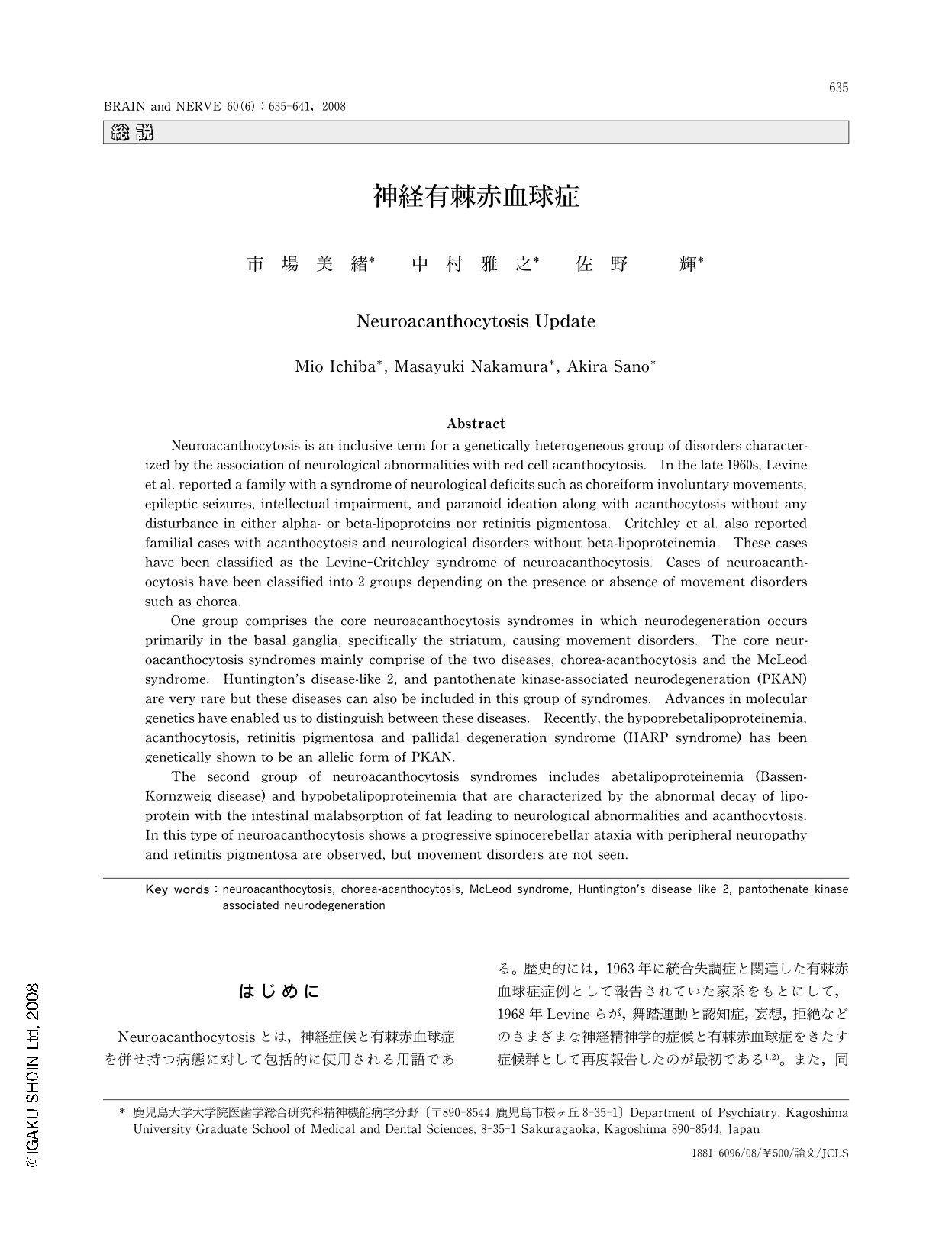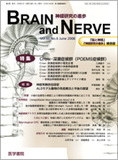Japanese
English
- 有料閲覧
- Abstract 文献概要
- 1ページ目 Look Inside
- 参考文献 Reference
はじめに
Neuroacanthocytosisとは,神経症候と有棘赤血球症を併せ持つ病態に対して包括的に使用される用語である。歴史的には,1963年に統合失調症と関連した有棘赤血球症症例として報告されていた家系をもとにして,1968年Levineらが,舞踏運動と認知症,妄想,拒絶などのさまざまな神経精神学的症候と有棘赤血球症をきたす症候群として再度報告したのが最初である1,2)。また,同年にCritchleyらも有棘赤血球症,舞踏運動および健忘などの神経精神学的症候を認める症例で,発端者の兄弟3人がてんかん発作と精神病をきたした家系を報告した3)。これらの報告以降,有棘赤血球症と神経精神症候をきたす疾患として,Levine-Critchley syndromeあるいはneuroacanthocytosisという疾患概念が誕生した。
Neuroacanthocytosisは臨床的な神経症候において,舞踏運動などのいわゆるmovement disorderを呈する群と呈さない2群に大別される。
前者として,主に尾状核や被核などの大脳基底核の神経変性を生じ,舞踏運動などのmovement disorderが現れる中核群が挙げられる。この病態については1991年に,Hardieらが臨床所見と剖検結果として線条体の神経変性を報告している4)。中核群の多くは有棘赤血球舞踏病(chorea-acanthocytosis: ChAc)とMcLeod症候群(McLeod syndrome: MLS)で占められ,少数例としてHuntingtong's disease-like 2(HDL2)やパントテン酸キナーゼ関連神経変性(pantothenate kinase associated neurodegeneration: PKAN)もこの群に含まれる。分子遺伝学的研究の進歩により,これらの疾患の病因遺伝子がいずれも明らかにされ,遺伝子診断により確定診断が可能となっている。最近,hypoprebetalipoproteinemia,acanthocytosis,retinitis pigmentosa and pallidal degeneration(HARP症候群)が遺伝的にPKANの一部であることがわかってきた。
他方,movement disorderを呈さない群として,リポ蛋白の低下に伴う脂質の吸収不全から神経障害と有棘赤血球症をきたす疾患が存在し,無βリポ蛋白血症(abetalipoproteinemia: ABL),低βリポ蛋白血症(hypobetalipoproteinemia)が挙げられる。これらの疾患においては,脊髄後索,末梢神経,網膜の障害を生じ,失調症状は認めるがいわゆるmovement disorderは生じない(Table1)。
Abstract
Neuroacanthocytosis is an inclusive term for a genetically heterogeneous group of disorders characterized by the association of neurological abnormalities with red cell acanthocytosis. In the late 1960s, Levine et al. reported a family with a syndrome of neurological deficits such as choreiform involuntary movements, epileptic seizures, intellectual impairment, and paranoid ideation along with acanthocytosis without any disturbance in either alpha- or beta-lipoproteins nor retinitis pigmentosa. Critchley et al. also reported familial cases with acanthocytosis and neurological disorders without beta-lipoproteinemia. These cases have been classified as the Levine-Critchley syndrome of neuroacanthocytosis. Cases of neuroacanthocytosis have been classified into 2 groups depending on the presence or absence of movement disorders such as chorea.
One group comprises the core neuroacanthocytosis syndromes in which neurodegeneration occurs primarily in the basal ganglia, specifically the striatum, causing movement disorders. The core neuroacanthocytosis syndromes mainly comprise of the two diseases, chorea-acanthocytosis and the McLeod syndrome. Huntington's disease-like 2, and pantothenate kinase-associated neurodegeneration (PKAN) are very rare but these diseases can also be included in this group of syndromes. Advances in molecular genetics have enabled us to distinguish between these diseases. Recently, the hypoprebetalipoproteinemia, acanthocytosis, retinitis pigmentosa and pallidal degeneration syndrome (HARP syndrome) has been genetically shown to be an allelic form of PKAN.
The second group of neuroacanthocytosis syndromes includes abetalipoproteinemia (Bassen-Kornzweig disease) and hypobetalipoproteinemia that are characterized by the abnormal decay of lipoprotein with the intestinal malabsorption of fat leading to neurological abnormalities and acanthocytosis. In this type of neuroacanthocytosis shows a progressive spinocerebellar ataxia with peripheral neuropathy and retinitis pigmentosa are observed, but movement disorders are not seen.

Copyright © 2008, Igaku-Shoin Ltd. All rights reserved.


